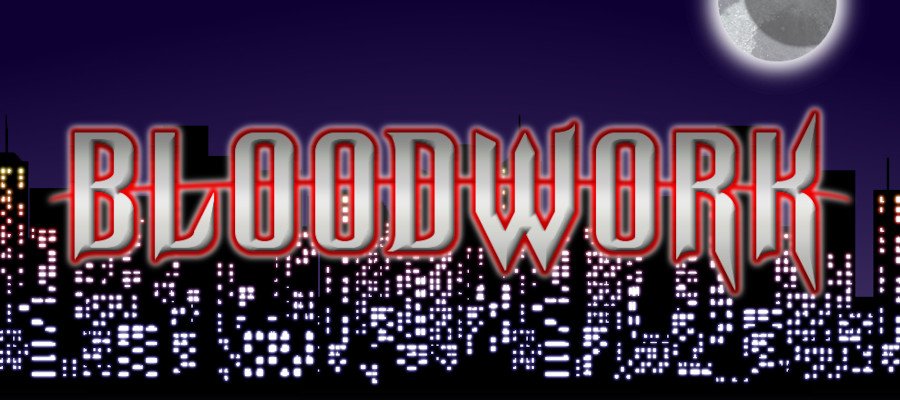Oh snappers it’s another one of these, and yes, I have not forgotten about Bloodwork even if I’m writing this two hours before it goes up!

The world has changed.
Not the world of Bloodwork! It’s still an early 2020s retrocurrent 1990s Vampire Fiction space where a war has broken out between the old vampire organisations and the young outcasts who don’t fit into the older orgs. It’s a space where the old families of noble power filtered through modern day power structures to take up their place in the human-exploitative machinery, the powerful and omnipresent systems that let them feed on humans in our everyday: Unchecked capitalism, and the police. These forces have power that allow them to respond to the random actions of the city around them.
Opposing these systems – not necessarily because they’re good rebels with a strong moral position but maybe just because they also want power and the Old vampires are eating all the pies – are the Young Vampires. Turns out you don’t need a moral framework to respond to radicalisation factors and when you and your enemies are both immortal it creates a new and intense form of impatience. The Young Vampires form gangs, small gangs that have to find ways to act immediately and abruptly.
It’s a choice between having infrastructure and long term plans and the capacity to take immediate, abrupt action.
Mechanically speaking, Bloodwork has really gone places from its original conception. When I started it, it was meant to be a project that was fast and simple to do, a Machi-Koro inspired, faction-free dice roller based on Liar’s Dice. You could roll a number and people had to guess whether you were telling the truth or lying, and if they guessed wrong, or didn’t guess, you got something. If you got caught lying, your opponents would claim an artifact from the cache of old vampire stuff and you only needed to do that a few times to win the game.
Over time talking with my colleagues – god I have colleagues – about it, Bloodwork took on a new idea as ways to represent types of vampire, and then that opened up mechanical space. The idea of a older vampire type playing with dice as a way to connect to older games rolling dice to kinda kick anything off, right?
As other projects (the writing) took my attention, Bloodwork took a backseat and that meant that I’ve actually had enough time since working on it directly that I’ve actually just forgotten a bunch of stuff! The capacity to forget is a super useful thing as a designer because it means you can see your own designs, not remember how you solved a problem, then re-solve it in a new way you find more interesting. That’s pretty cool and also deeply irritating. On the one hand, it’s replicating work, on the other hand it’s making every part of the game something you find more interesting in general.
The other thing that’s changed in the world is that I simply don’t have access to the printing tools I had this time even last year. DrivethruCards, one of the services I used for exclusive card printing games, and why the bulk of my games library is made up of card games, don’t do printing for a variety of games at the rate they used to do. Shipping rates and times for everything outside of Australia has gotten slower and worse.
There are now two services within Australia that offer me apparently the basics of the tools I want, but I can’t promise that they actually do the job they say they do, because neither of them are the same kind of services as Drivethru and its cousin Gamecrafter. Those services used web front ends, which meant that when I wanted to make something, I was just playing with the pieces bit by bit, and as I was building it, I could put the plan together while building it. It was a very different tone.
What I have to do now is instead construct a plan with measurements and send them to a business to be reviewed, and that’s really different to what I’m used to. I haven’t even internalised the names of these companies I’m ostensibly using.
Gamecrafter has its place, though! I can make a plan in Gamecrafter, get a general price point, and see if that makes me comfortable. I know I’m dealing with vibes here – is a game a good enough game for its price point? Personally, I’d love to make my microgames as hook games on Gamecrafter, because it’s so nice and tidy – but there are infrastructural reasons not to.
Basically, if I do that, I won’t be able to sell them at a good rate, right?
Or are all the prices going to go up?
The big development I think for Bloodwork is that I think the game needs a third space. It used to be that the game had a marketplace – just a common space where you could pick up vampires or assets and put blood down to pay for them. The more I think about it, though, if half of the factions are meant to feel like they exist in a city, then it means that there needs to be some feelings of things like a city.
What I think I’m doing is changing the way the market works. Specifically, instead of a marketplace, where you pick vampires freely, Vampires come off the top of a deck, converted out of people in the common area. But people in the common area can take actions and change the game state, so that there’s a reason for you to care about humans. Humans act in the ‘off’ turn – when everyone else is doing things, after that night phase, there needs to be some reward for keeping humans around in your organisation.
Another tool I’ve started playing with lately is a way to talk about how to present a game, in that I need answers to these three principles:
- Approach – How does the game get you involved in it?
- Interface – How do you interact with the game?
- Offering – What’s the fantasy of the game when you’re doing that?
Okay, there, that’s an update, and I have eight minutes to spare.
